Dogs That Don’t Shed List – Small, Medium, Big Dogs That Don’t Shed A Lot
Table Of Contents
- 1 32 Dogs That Don’t Shed
- 1.1 1. Australian Silky Terrier
- 1.2 2. Affenpinscher
- 1.3 3. Basenji
- 1.4 4. Bedlington Terrier
- 1.5 5. The Bichon Frise
- 1.6 6. Bolognese
- 1.7 7. Brussels Griffon
- 1.8 8. Cairn Terrier
- 1.9 9. Chinese Crested Dog
- 1.10 10. Coton De Tulear
- 1.11 11. The Havanese
- 1.12 12. Lhasa Apso
- 1.13 13. Maltese
- 1.14 14. Miniature Schnauzer
- 1.15 15. Scottish terrier
- 1.16 16. Shih Tzu
- 1.17 17. Poodles (toy and standard)
- 1.18 18. West Highland White Terrier
- 1.19 19. Yorkshire Terrier
- 1.20 20. Irish Terrier
- 1.21 21. Kerry Blue Terrier
- 1.22 22. Lakeland Terrier
- 1.23 23. The Standard Schnauzer
- 1.24 24. The Tibetan Terrier
- 1.25 26. Airedale Terrier
- 1.26 27. Bouvier Des Flandres
- 1.27 28. Irish Water Spaniel
- 1.28 29. Giant Schnauzer
- 1.29 30. Komondor
- 1.30 31. Portuguese Water Dog
- 1.31 32. Saluki
Shedding. Falling hair can be a dog owner’s nightmare.
Hence, many pet lovers prefer to have a non-shedding dog. It’s not surprising because pet dander carries nasty allergens. Here is a compiled list of non-shedding breeds, and their history.
32 Dogs That Don’t Shed
1. Australian Silky Terrier
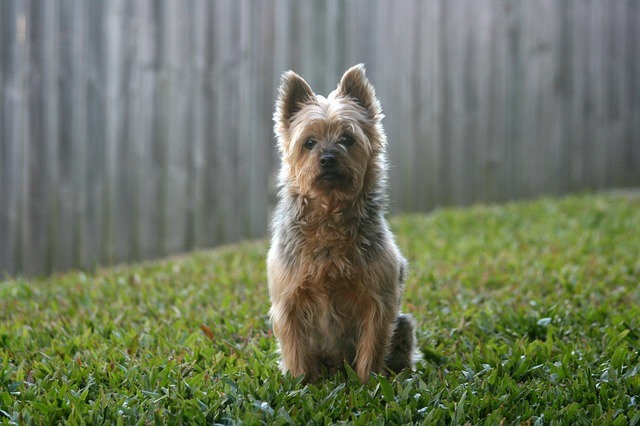
The Australian Silky Terrier is a small dog that doesn’t shed. This feisty little fellow has a silky coat that flows from head to toe.
This fellow is the proud descendant of the Yorkshire Terrier and the Australian Terrier (Surprisingly, its Australian parent is a somewhat rough-coated dog). Based on records kept by the American Kennel Club, it came to be at the turn of the 20th century when breeders first crossed Yorkies with Australian Terriers.
The breed was first known as the Sydney Silky because it was a native of Sydney. It was an urban pet bred to kill snakes.
Until 1929, the Australian Terrier, Australian Silky Terrier, and the Yorkie were not defined breeds. All three could come from the same litter. Kennel clubs discouraged cross breeding in 1955, and it became the Australian Silky Terrier.
American soldiers brought the dog back to their country. It caught on in the United States after photographs of it appeared in newspapers. The AKC recognized the breed in 1959, and the United Kennel Club acknowledged it in 1965. The Federation Cynologique Internationale listed it as breed number 236. Small kennel clubs recognize it as well.
Digging and barking are the Silky’s favorite hobbies. They take training and patience to keep in check. Occupy your active Silky with walks and play, or it will choose to dig up the backyard.
Australian Silky Terriers can be destructive. Give it a sandbox where it can make messes if you don’t want holes in your garden. These dogs are bold; they’re always ready for a little rough and tumble. They suit families with older kids, as they are a bundle of frivolous energy.
The Australian Silky Terrier doesn’t shed but needs regular brushing for its silky coat to stay impeccable. It’s long-haired, so use a rake comb to move through its fur.
2. Affenpinscher
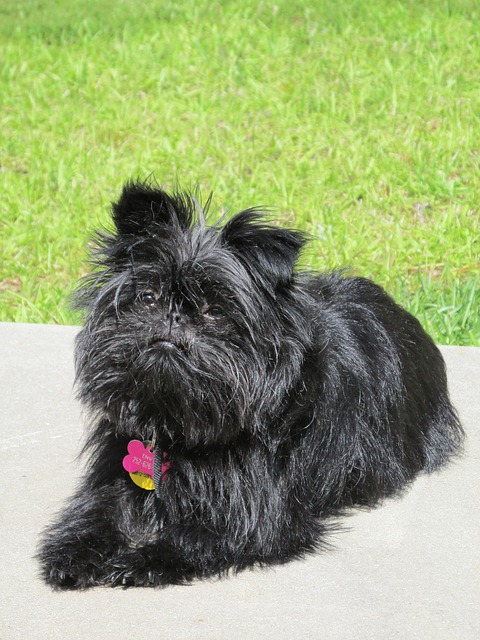
Otherwise known as the Monkey Terrier, the Affenpinscher has German origins. It dates back to the 17th century. ‘Affe’ means ‘monkey.’ A small dog that weighs between 6.5 to 13.2 pounds, the Affenpinscher has a monkey-like expression.
This little dog is a cross between a Miniature Schnauzer and the Griffon Bruxellois. The first ones were about 12 to 13 inches long and had gray, fawn, black, or tan coats. Breeders used them to remove rodents from stables.
A little Affenpinscher named Banana Joe V Tani Kazari won the Best In Show Title at the Westminister Kennel Club Dog Show in New York City.
This dog has a shaggy coat, especially over the head. The hind hairs are shorter than those in front. It’s wiry when properly maintained. Use a slicker brush or a greyhound comb.
Start with its chest and chin. Move to its belly, then the inside of its legs. Comb the hairs on the outside of its legs and then, its back. Finally, comb the hair on its face.
This dog doesn’t shed, but you will need to remove occasional mats. Use a detangler for this purpose. Cut them off if they are too thick.
3. Basenji
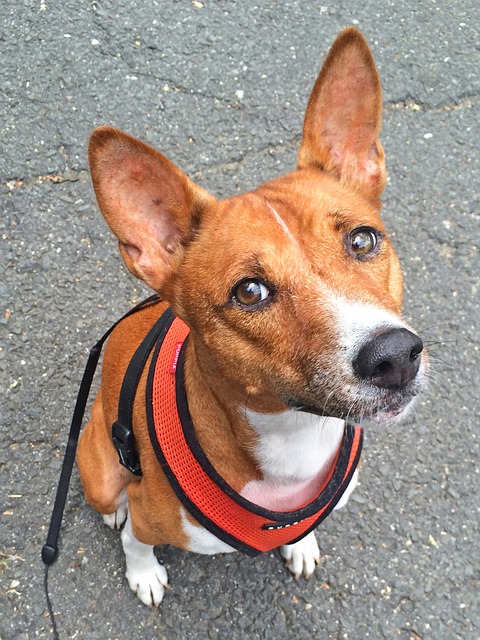
You may like this dog if noise is an issue because it doesn’t bark. This dog is renowned for its sharp wit and doesn’t shed.
This little fellow has African roots. Basenjis have lived with the people of Africa for thousands of years. The Tesem, which resemble them, are often seen on the walls of Egyptian tombs. They have pricked ears and tails that curl slightly.
Europeans first described them as the Congo. People prized them for their intelligence and their ability to listen. They aren’t always obedient; they will obey commands only if they are reasonable or beneficial.
These dogs were hunters. Breeders produced them to hunt small game, which they would catch and drop into nets.
The earliest imports to England died from diseases. Lady Helen Nutting, who brought six in from Sudan, died from distemper. The foundation stock finally came to England in the 1930s.
Animal importer Henry Trefflich brought them to America in the 1930s. The American Kennel Club recognized it in 1943. It opened its stud book to 14 imports at the request of the Basenji Club of America. They reopened it again between 2009 and 2013. An American expedition collected more Basenjis from the Basankusu area of Congo.
You will know a Basenji when you see one. It has a smooth, muscular appearance, much like a Jack Russell Terrier. They are effortlessly athletic and have elegant strides. They have almond-shaped heads and eyes. They have tricolor coats of black, chestnut, and white. You could describe them as miniature deer.
A Basenji is clean. It is short-haired but doesn’t have a dog odor. Bathe it regularly and comb its hair with a bristle brush.
4. Bedlington Terrier
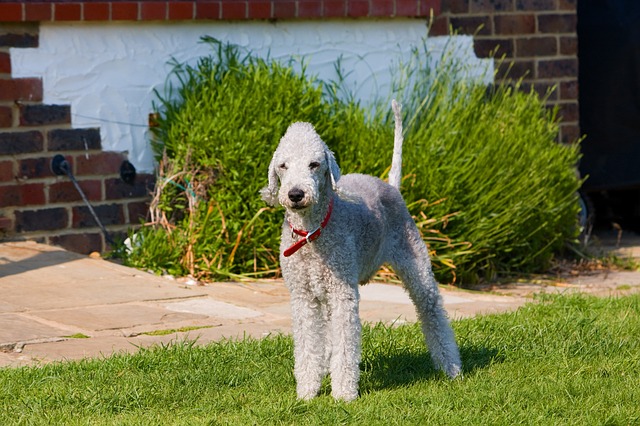
This little dog comes from the mining town of Bedlington in North East England.
Miners first bred Bedlington Terriers to catch vermin. Known initially as Rodbury Terriers, they became the favorite companions of miners. The earliest of these dogs appeared in 1782.
These pets were also known as the Gypsy dogs because the Gypsies, too, used them for hunting. The aristocracy valued them for being able to retrieve game as well. Lord Rothbury had taken a liking to these dogs. James Allen first described them in his book The Life of James Allen. William, his father, loved them for their rabbit coursing and racing abilities.
Young Piper was the first recognized Bedlington Terrier, and it belonged to a man named Joseph Ainsley. It had a reputation for its courage. Young Piper hunted badgers from the age of eight months and went on doing so until it was blind.
The Bedlington has a strong prey drive because of its hunting heritage. It is active and needs physical stimulation. Like its terrier relatives, it loves digging, so give it a sandbox if you don’t want a garden full of holes.
The Bedlington is intelligent but wilful. Positivity and consistency is the key to successful training.
Like other terrier types, this dog doesn’t shed. However, its lamb-like haircuts need some maintenance. Its curly coat requires regular brushing with a slicker brush. It will need professional clipping every two months.
5. The Bichon Frise
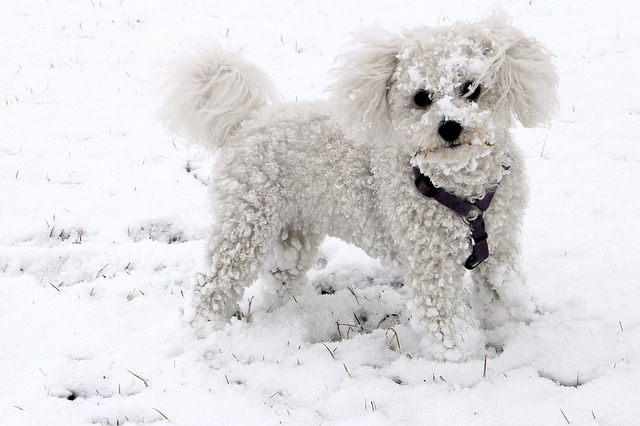
The Bichon Frise is renowned for its curly coat. Kennel Clubs recognize it as a non-sporting, toy dog.
Dog historians depict it as a French breed. However, it has Spanish roots. Spanish sailors first brought Bichons aboard their ships as barter. They introduced the dogs to the people of Tenerife, the largest of the Canary Islands. Italian sailors discovered the dogs, which became a favorite of the nobility.
Bichon Frises became popular in the French court during the reign of Francis, but the court of Henry III was even fonder of them. The breed also became a favorite among the Infantas and painters of Spain. For example, Francisco De Goya included Bichons in some of his paintings.
The Societe Centrale De Canine, the national kennel club of France, adopted the breed in 1933. It was a street dog that accompanied organ grinders. It worked with people with disabilities and performed at circus shows. It gained popularity due to the success of The Adventures of Tin Tin, the famous comic strip that featured a fluffy terrier named Milou.
The Bichon Frise arrived in the United States in 1955. The first US-born littler came to be in 1956. Two more breeders acquired Bichons, which fostered further development of the dog.
It entered the American Kennel Club’s Miscellaneous Class of Dogs in 1971 and made it to their Stud Book in 1972. A Bichon named JR won the Best In Show title at the Westminister Kennel Club Dog Show in 2001. It was the 40th most popular dog breed in America in 2013.
Bichons have an alternative name, ‘Curly Lap Dog,’ which tells you what hair type it has. Brush it with a slicker brush regularly to prevent shedding and mats. Note that you will need to clip it occasionally.
First, cut between the bottoms of the paws. Work in the direction of the hair growth, being careful not to clip the hair around the legs as you’ll need to use scissors.
After doing this, brush the hair straight down. Use the scissors and cut a straight line from the body to the tips of its paws. They must be round, so cut the hair in a circle.
6. Bolognese
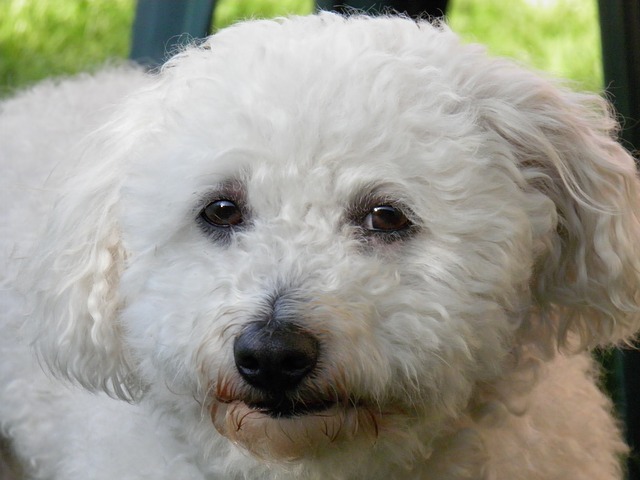
The Bolognese, like its Bichon relative, doesn’t shed. Considered a companion breed, it’s exceptionally sociable. It gets along with people and pets, big and small. This dog forms bonds quickly.
The Bolognese belongs to the Bichon group, which includes the Maltese, Lowchen, and the Havanese. It was a favorite of the Italian aristocracy. Breeders established the first litter in Bologna in 1200. Its closest relative of the Bichon group is the Maltese.
Flemish artisans depicted the dog in their work as early as the 17th century. Titan, the Venetian painter, captured Duke Federico Gonzalo with his Bolognese. It was a favorite of the notable European aristocracy, including Catherine the Great of Russia and Madame de Pompadour.
Liz Stannard brought the breed to England in 1990.The UK Kennel Club first showed it during that year. They first appeared at an international dog show in Crufts in 2002.
The Bolognese has long hair, so it is best to use a rake or greyhound comb. You should wash around its eyes and use a commercial cleaner to clean its ears.
7. Brussels Griffon
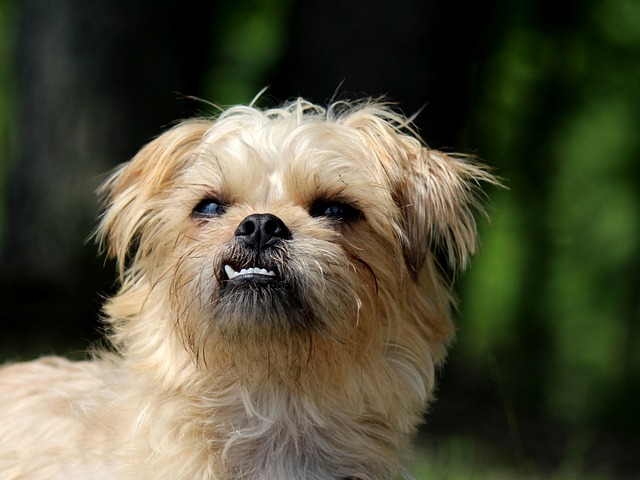
Another cute little dog that doesn’t shed the Brussels Griffon. This toy dog hails from, of course, Belgium. There are three variations of the breed, namely the Brussels Griffon, the Belgian Griffon, and the Petit Brabanchon.
Breeders First kept it in stables to get rid of rodents. Its ancestor is a small, terrier-type dog called a Smousje. It is small and has a wiry coat. Belgian coachmen grew fond of these little fellows and bred them with King Charles Spaniels and Pugs. The spaniel gave the dog its red or black hair.
The Brussels Griffon rose in popularity in the 19th century. The Belgians, regardless of social status, loved this dog. Belgium’s Kennel Club stud book registered it in 1883.
So cute was this dog that even members of Belgian royalty couldn’t keep their hands off it. It appeared in the court of Queen Marie Hennette, who was a dog enthusiast. She
Began breeding it together with her daughter.
The breed declined during the first and second world wars. Their numbers shrank alarmingly. Almost none remained after the second world war.
Adorable as it is, it has never been numerous. There has been a recent interest in the breed because of its appearance in the movie as Good As It Gets.
This fellow has a wiry coat which doesn’t molt. Clip it short and brush it regularly with a slicker brush.
8. Cairn Terrier
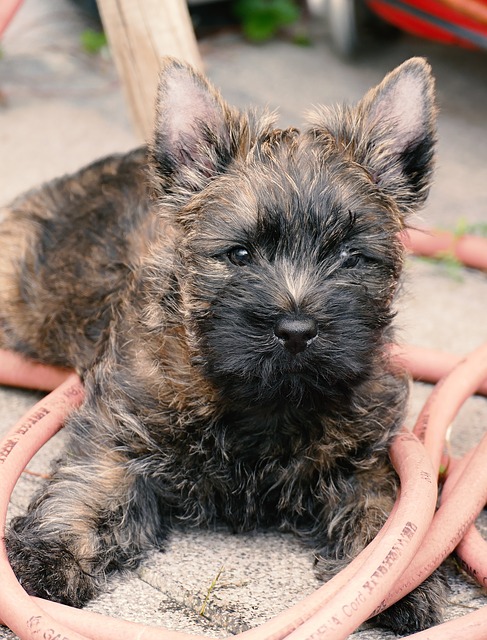
Meet Toto from The Wizard of Oz. Yes, the iconic dog in the 1939 movie was a Cairn Terrier. You will welcome it as a guest because it doesn’t shed.
This Terrier originated in the Highlands of Scotland, and like its Terrier cousins, breeders produced it to capture vermin in farms. It also hunted badgers, otters, and foxes. The Cairn had a reputation for being able to scale jagged rock and keep its balance. This ability made them especially useful for retrieving game.
Cairns come from the Scottish terrier group of dogs. Breeders divided the breed into two distinct types of dogs – the Skye Terrier and the Dandie Dinmont. They further separated Terriers with rough hair from those with silky coats. The Cairn, West Highland White Terrier, and the Scotch belonged to the rough-coated group.
Earlier Cairn Terriers were almost white. Breeders stopped crossing them with West Highland Whites by 1920. It gained popularity in England and later America, especially after one of them played Toto in The Wizard of Oz.
The Cairn Terrier Club of the United Kingdom’s motto, ‘the best little pal in the world,’ describes this little Cairn’s personality to a T. Like all Terriers, it is a little dominant but is fiercely faithful to its owner. It’s also loving and sociable. Energetic, it loves to scamper.
Like other Terriers, it needs regular brushing with a slicker brush. You may want two hand-strip it to give it the signature Terrier haircut.
When hand-stripping this dog, ensure that you work in the direction of the hair growth. Try different stripping knives until you find one that’s constable for you.
9. Chinese Crested Dog
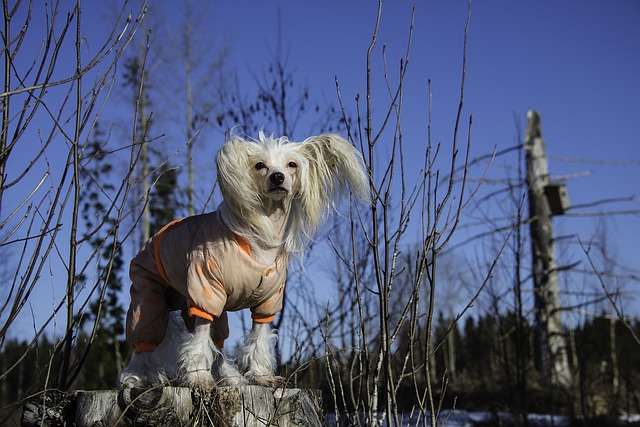
Are you looking for a dog that will stand out as you walk on the street? Meet the Chinese Crested. It doesn’t shed because it hasn’t much hair to lose.
It may surprise you that it doesn’t originate from China. Many believe that it has its roots in Africa.
The Africans first called it the African Hairless Terrier. The name appeared in several 19th-century texts. It became known as the Chinese Crested because Chinese sailors used it on board their ships to catch rats. It was also a companion for people with disabilities.
Deborah Wood, an enthusiast, created the ‘ Crest Haven’ kennel. She began to breed and record the behavior of Chinese Crested dogs. Burlesque dancer Gypsy Rose Lee kept them as well. These dogs became the ancestors of every Chinese Crested today.
Miss Wood founded the American Hairless Dog Club in 1959. This club became Incorporated into the American Chinese Crested Club in 1978. It became the club for the breed when the American Kennel Club acknowledged it in 1991.
The Fédération Cynologique Internationale, the Kennel Club of France, acknowledged it in 1987, and the UK Kennel Club recognized it in 1991. Australian National Kennel Club listed it as a breed in 1995.
Contrary to what you may think, the Chinese Crested isn’t completely hairless. It shouldn’t have a plume on its head and tail. Its legs should have feathers as well. Use a greyhound comb and clippers to style its head, tail and the hairs on its feet.
10. Coton De Tulear
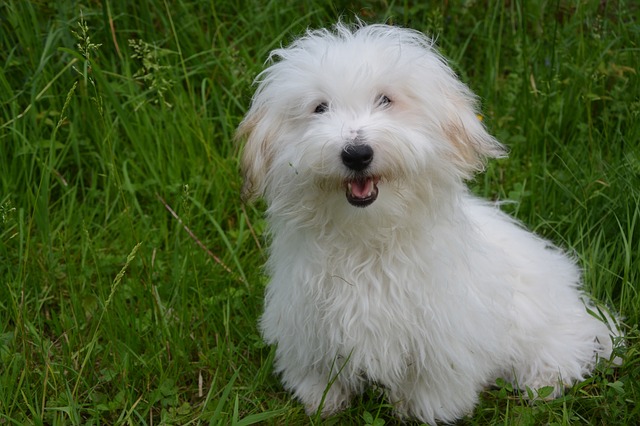
Do you want a somewhat playful, long-haired dog that doesn’t shed? Consider the Coron De Tulear. With its long locks, it sometimes resembles Casper the Ghost.
This breed has African heritage. It originated in the island of Madagascar and is Its national dog. It belongs to the Bichon-Tenerife group of dogs, Sailors brought Cotons to the island and mated them with local dogs. The result of the mating was unexpected though pleasant.
Madagascar was, and still is a pirate haven. Pirates brought the Tenerife dogs to capture rats and as companions. However, it was never a feral dog. Owing to its size and lack of strength, it wasn’t a hunting dog.
Its cottony coat caught the attention of Madagascar royalty. Dr. Robert Jay Russell brought the first ones to the United States in 1973. He coined the phrase ‘The royal dog of Madagascar’ for the breed. The French imported them as well. The government of Madagascar released a stamp with the dog’s image in 1974.
The Societe Centrale Canine of France acknowledged it in 1970, and the Fédération Cynologique Internationale published the breed standard in 1972. The New Zealand Kennel Club and the Australian National Kennel Union don’t recognize this breed. However, minor registries may acknowledge it.
Dr. Robert J Russell, a biologist, developed another standard for the breed in 1974. He established the Coton De Tulear club of America in 1976 opposed registration by the American Kennel Club. It became a fully recognized breed in 2014. Its parent Club is the United States of America Coton de Tulear Club.
This dog will keep you on your toes. It’s playful, and owners love it for being able to dance on its hind legs. This fellow is sociable and enjoys the company of other pets and people.
The Coton De Tulear requires regular bathing and brushing. Because there’s enormous variation in the texture, of its coat, you will need different brushes to groom it successfully. Greyhound combs, slicker brushes, and rakes must work together on this dog’s hair.
11. The Havanese
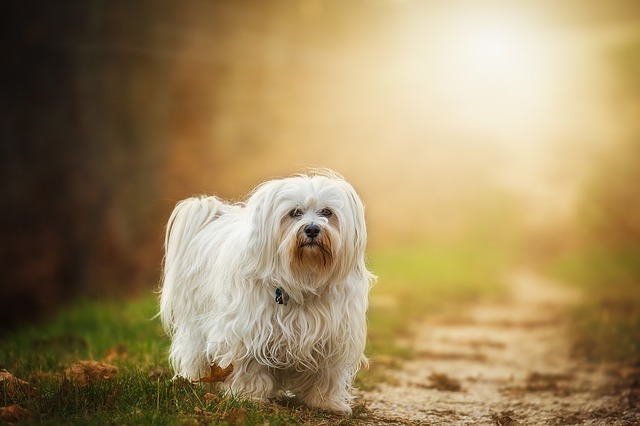
Another Bichon-type dog, the Havanese, is another long-haired dog that doesn’t shed.
This dog developed from the Bianquito de la Habana, or the little white dog of Havana, which is now extinct. Breeders crossbred it with other bichon-type dogs to create the Havanese.
Like other Bichon dogs, its ancestors are supposed to have come from Tenerife, one of the Canary Islands. Some dog experts believe that it came from Malta.
During the Cuban Revolution, upper-class Cubans sought asylum in the United States. American breeders became interested in this white fellow. The gene pool was only 11 dogs in 1970. The American Kennel Club only recognized the breed in 1996. It is now the 25th most popular breed in America.
Like the rest of the Bichon family, the Havanese is sociable. It’s comfortable for people and pets.
This dog is healthy and lives for about 14 years. It may develop patella luxation (a dislocated kneecap) as it ages. Older Havanese may have cataracts.
The Havanese doesn’t lose much hair, but it is long. Therefore, regular combing with a rake is necessary to keep its coat free of dead hair. If you are using clipping shears, number 40 will prevent it from becoming clipped too short.
12. Lhasa Apso
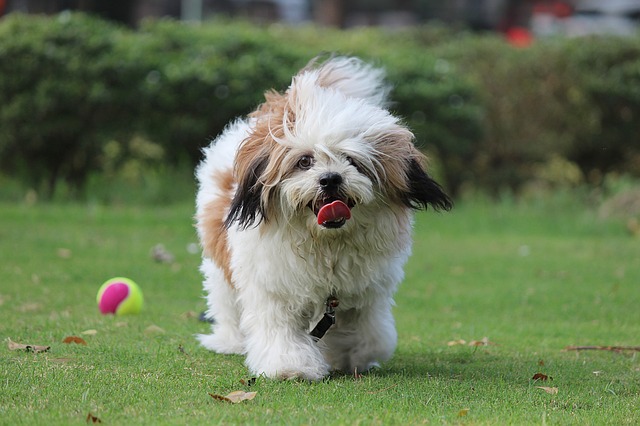
This charming Tibetan dog has long hair and bears a striking resemblance to Cousin It from The Addams Family.
Tibetan Monks used Lhasa Apsos as sentinels in their monasteries. These little guardians warned the monks if any intruders were afoot. They originated in the Tibetan City of Lhasa. Apso means ‘bearded’ the two words together mean ‘long-haired Lhasa dog.’
The Lhasa Apso came from the Himalayan mountains and is closely related to The ancestral wolf. Some Tibetans refer to it as the ‘bearded lion dog.’ It served as an excellent guard dog in Tibetan households and kept them safe with its sharp bark. Many natives believed that the lamas could enter the souls of these creatures.
British military soldiers brought some of them back to England in the 1900s. The 13th Dalai Lama, Thubten Gyatso, gave some of them as gifts to C. Suydam Cutting, who arrived in the United States in 1933.
The American Kennel Club eventually recognized the Lhasa Apso as a breed in 1935. They put it in the terrier group and evaluated it as a non-sporting dog..
The Lasha Apso doesn’t have many health problems. Some may develop sebaceous adenitis, a hereditary skin disease. It may also suffer from retinal atrophy.
As a guardian, it is alert and intelligent. Since its job is to be watchful, it can be wary of strangers and other pets. They are independent and are loyal companions.
Since its hair is long, it will not shed much. Like humans, they do so slowly and continuously. Use a rake to move through its coat. When clipping it, use the number 40 blade as you want to avoid cutting the hair too short.
13. Maltese
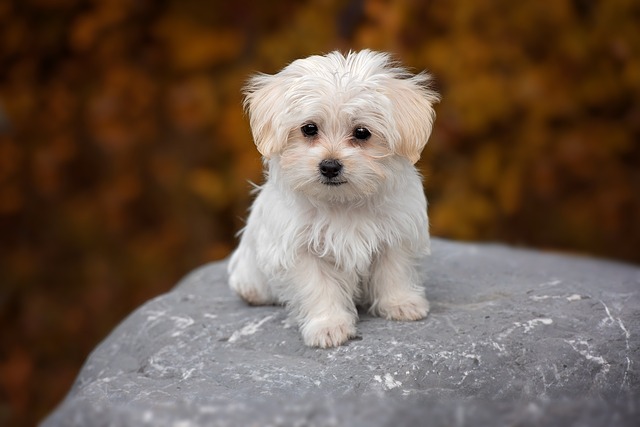
This little toy dog comes from the Central Mediterranean. It doesn’t shed its long white coat.
The Maltese dog is an ancient breed that has a variety of names. People have called it the ‘ ancient dog of Malta,’ the Roman Ladies dog and the Maltese Lion Dog. Kennel Clubs finally settled on the meme “Maltese.”
You may be surprised to know that it descends from the Spitz. Swiss Lake dwellers bred the dog selectively to preserve its small size. Some people believe that it has Asian origins and is related to the Tibetan Terrier. Traders probably brought it to Europe from the Middle East.
The earliest instance of the breed was in the Etruscan town of Vulci. Stephanus of Byzantium wrote a document describing the dog. The poet Martial wrote A Few verses about it as well. Female noble women loved this breed.
Queen Elizabeth I’s physician, John Caius, mentioned in his writings that it came from the Sicilian Strait. Jean Quintin of Altun, Secretary to The Grandmaster of the Knights of Malta Philippe Villiers de L’Isle-Adam, also featured the dog in his work.
Breeders wanted to improve the dog’s quality by making it even smaller. It was about the size of a squirrel in 1792.
Pure white Maltese dogs are more acceptable than those that are off-white. You will find the latter in the south of France.
This dog makes an ideal companion. It is energetic and extremely playful. Note that you should supervise children when they play with it. It fares well in apartments.
The Maltese dog has long hair which you should comb with a rake. Do so regularly to dispense oils naturally and avoid mats. When using clippers, choose number 40 to avoid cutting the hair too short.
14. Miniature Schnauzer
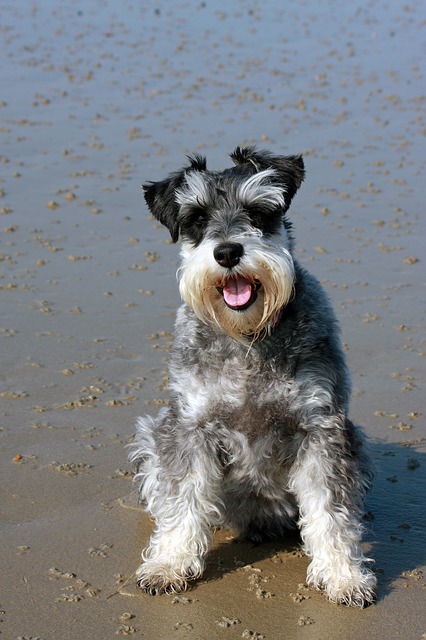
This German native is a small fellow that doesn’t lose much hair. It is a mix of the Standard Schnauzer and smaller breeds like the Poodle.
The earliest records of the Standard Schnauzer come from the 19th century. Schnauzers were farm dogs bred for catching vermin. The first Mini Schnauzer appeared in 1888. Breeders showcased schnauzers in an exhibition in 1889.
The American Kennel Club registered the breed in 1926, two years after it came to America. Breeders first called Schnauzers Wirehaired Pinschers. They fall in the utility category in America and the working group in Europe.
Dorem Display was the first Miniature Schnauzer to secure the Best in Show title. Born in 1945, it lived for 14 years. The Schnauzer is the 11th most popular breed in America today.
This dog is lively and alert. It’s also incredibly playful. Left to its own devices, it may have a little too much fun. Because it caught rats in its early years, it has an active prey drive.
It has overall good health but may suffer from problems due to high-fat levels.
The Schnauzer has wiry, short hair. A slicker brush works best for this dog. It has a specific cut, and stripping may be necessary to keep its coat short.
15. Scottish terrier
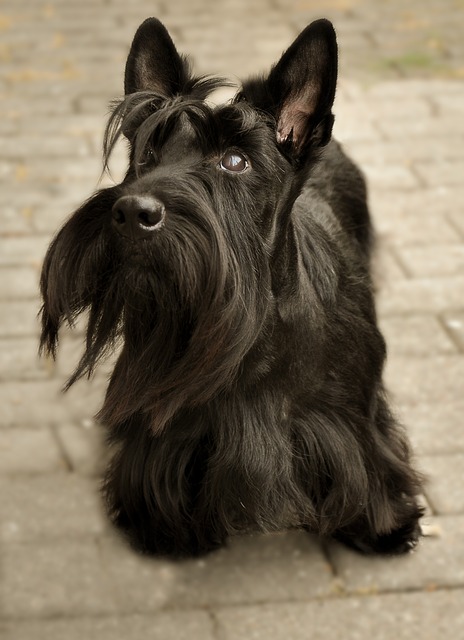
Also known as the Aberdeen Terrier, this little fellow is one of the Skye Terrier group of dogs. The modern Skye Terrier, West Highland white terrier, Cairn terrier, and the Dandie Dinmont share the same heritage. All hail from the Scottish Highlands. Grouping them confused their lineage. Scotties and West Highlands share the closest relationship.
Its history is somewhat obscure. The first records of a dog similar to the Scottish terrier date back to 1436, when a writer, Don Leslie, described it in the History of Scotland.
King James VI was the monarch that featured most in this dog’s history. When he became James I, he gave them as a gift to the French King. The popularity of the breed grew.
Two terrier breeds existed in England at that time. One was the Scottish terrier and the other, the English terrier. The former had a rough coat while the latter had silky hair. They were abundant in the Scottish Highlands at the time.
Breeders decided to develop pure bloodlines in the 19th century. The Birmingham England dog show in 1860 was the first to showcase these Terriers. They included the ancestors of the Scottie.
They featured in dog shows in the 1870s, when the development of the breed standard first started. The Scottish terrier, West Highland white terrier, Cairn Terrier, and the Dandie Dinmont became separate breeds.
Owner’s first exhibited them at Alexander Palace in England in 1879. It appeared In Vero Shaw’s Illustrated Book Of The Dog in 1880.
Enthusiasts set up the Scottish Terrier Club of England in 1881. The secretary, H.J. Ludlow, popularized the breed in Great Britain. The Scottish Terrier Club of Scotland came into being. Both clubs couldn’t agree on the breed’s standard. They finally did so in 1930 and based it on four dogs – Heather Necessity, Airbourne Barty, Airbourne Annie Laurie and Miss Wijk’s Marksman.
The Scottie came to America in the 1890s but only became popular after World War II. The United Kennel Club first recognized it in 1934. It has won the Westminister Kennel Club dog show more than any other breed. Famous Scotties include Fala, a dog owned by President Franklin D Roosevelt. Eleanor Roosevelt had a Scottie named Maggie. Queen Victoria, Eva Braun, and more recently, George W Bush had Scottish terriers. It appears in the famous board game, Monopoly.
Like other Terriers, it is sociable and intelligent. It is also brave. It is susceptible to Von Willebrand disease and Cardiovascular Osteopathy.
Brush its rough coat with a bristle brush regularly. Use a detangler to remove mats. It hairs require regular clipping.
16. Shih Tzu
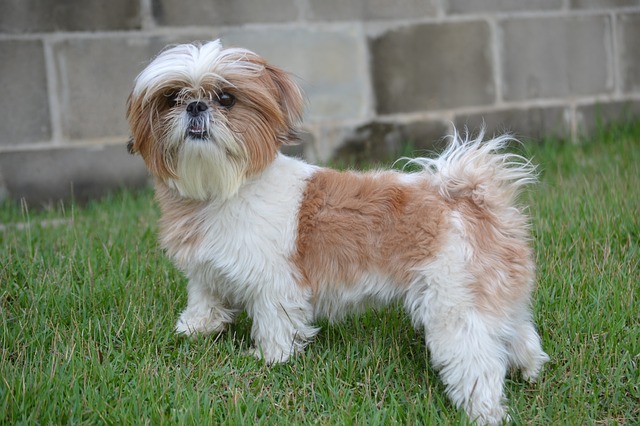
Known as the Chrysanthemum Dog, the Shih Tzu is a toy breed that weighs only 8 kilograms and doesn’t shed. Like the Lhasa Apso, it originated in Tibet. The Shih Tzu is not a new dog breed. Dog enthusiasts have traced its ancestry to wolves.
Modern theorists say that it is a cross between the Pekingese and the Lhasa Apso. The Dalai Lama gave them as gifts at the end of the 17th century.
They arrived in Europe in 1930, and kennel clubs classified them as Apsos. They were the favorite of Chinese royalty. The Europeans established the first breed standard in 1930. The dogs went to the United States after World War II.
Major kennel clubs now recognize the Shih Tzu. The Fédération Cynologique Internationale puts it in the toy dog group. The American Kennel Club rated it as the 15th most popular breed in 2013. Breeders established the Shih Tzu Club of England in 1934. It became eligible to receive challenge certificates soon after.
The Shih Tzu is prone to some health issues. It may develop hyperthyroidism or the malfunctioning of the thyroid gland. Hypothyroidism impedes metabolism.
Being a long-haired breed, the Shih Tzu meet regular combing with a rake. Doing this removes pet dander.
The Shih Tzu is a short-nosed, brachycephalic breed. Its tongue may block its airway and cause occasional breathing difficulties. Furthermore, it is susceptible to intervertebral disc disease, characterized by back pain.
This fellow is affectionate, gentle, and obliging. It’s a little shy, so socializing should take place at a young age.
You may want to have it professionally clipped. If you wish to do some cutting yourself, use the number 40 blade on your set of clippers.
17. Poodles (toy and standard)
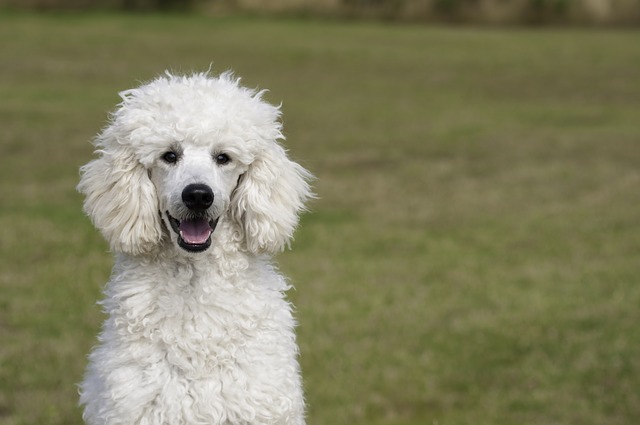
This elegant charmer is both lovely to look at and cuddle. And it doesn’t have hair loss. It’s the second smartest dog in the world after the Border Collie.
The poodle comes from a group of formal dog breeds. People are still debating its history. Some say that it comes from Germany and is a water dog, but others dispute this.
This little dog not only looks good but also excels in many water sports. It is competent in agility and tracking activities. People first used it as a circus performer.. It frequently wins the Best in Show title at Westminster Kennel Club dog shows. It secured the same title at Crufts in 1982.
Its name originates from the German Pudel, which means ‘to splash about.’ The name came about because hunters used it to retrieve game that fell in lakes and ponds.
The European mainland was familiar with this dog. German artist Albrecht Durer captured its image in his work. Many saw them as pampered pets, and that impression has stuck.
The Poodle has contributed its genes to many crossbreeds. Some include the miniature schnauzer, the Standard Schnauzer, the Labradoodle(Labrador and Poodle), the Goldendoodle(Golden Retriever and Poodle), and most recently, the Peekapoo(Pekingese and Poodle).
Poodles are highly intelligent; they require physical and mental stimulation. They are highly trainable and understand obedience commands quickly. These dogs do well with families if the environment is orderly. Note that they can be aggressive when teased, so they may not do well in homes with active teenagers.
Poodles may develop hip dysplasia(dislocated hip bone) or a collapsed trachea. Their non-shedding coats may grow into their ear canals.
Poodles are hypoallergenic and have hair that grows for longer than other breeds of dogs. Although they don’t shed, their coats need a lot of brushing. Use a bristle brush and a detangler to remove mats. A professional groomer can give it the signature Poodle cut.
18. West Highland White Terrier
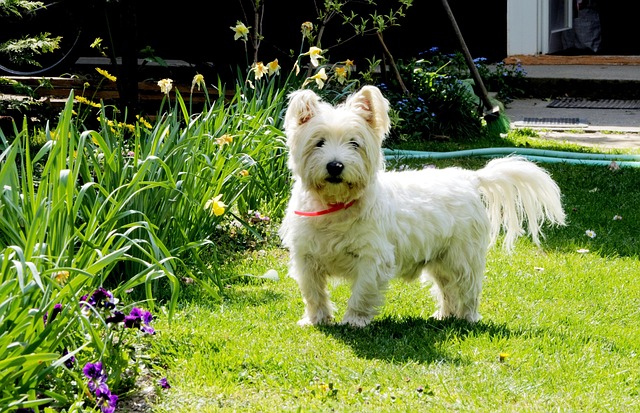
Is fun and good looks what you look for in a pet? Meet the West Highland White Terrier. This rambunctious fellow is an adorable bundle of joy. It belongs to the Scottish Terrier group that includes The Cairn Terrier, Scottish Terrier, and the Dandie Dinmont.
This dog has been in existence since the time of James the VI of Scotland. (R. 1567 – 1625). He instructed his courtiers to procure a dozen terriers from Argyll to give to France. At this time, people saw terriers with brindle coats as superior to white ones..
The Westie, the affectionate term for the West Highland, apparently arrived aboard one of the ships of the wrecked Spanish Armada. It wrecked on Skye Island and carried White Spanish Dogs. Clan Donald, a breeder, kept their lineage distinct.
The 8th Duke of Argyll, George Campbell, bred White Scottish Terriers he named Roseneath Terriers. At the same time, Dr. Americ Flaxman produced a line of Pitterween Terriers.
The perspective that white terriers were inferior remained. Flaxman’s female seemed to produce white dogs, no matter how he tried to get rid of them. He concluded that it was a strain of Scottish terriers trying to surface.
Edward Donald Malcolm was most responsible for breeding the modern Westie. The story goes that he shot a red terrier, mistaking it for a fox. He didn’t want to make the same error, so he developed a strain of white terriers called Poltaloch Terriers. They were sandy and had pointed ears, much like the Westie today.
In 1904, Neil Campbell, the 10th Duke of Argyll, set up the first West Highland White Terrier breed club, with the Countess of Aberdeen as its chairperson. The Westie arrived in the United States in 1907 and gained recognition from the American Kennel Club in 1908. Canadian Kennel Club recognition followed a year later.
The Westie stands out because it is adorable. Ch Morvan, a Westie owned by Colin Young, was the first of the breed to win a show championship title. It was victorious at the Scottish Kennel Club dog show. The first Westie winner of the Westminister Kennel Club Dog show was Wolvey Pattern, owned by Constance Winant The Westie, with its intelligence and cuteness, has continued to win championship titles to this date.
The Westie is predisposed to genetic conditions like Abdominal Hernias and a disease known as the Westie Jaw. It only becomes affected if both its parents carry the defective gene. It may recede by the time the dog becomes a year old.
Some Westies are friendly towards children, while others may value their independence. The latter will not tolerate a child pulling its ears. It can also be possessive of its toys or food. A Westie is typically self-assured and independent. This dog is famous for having quite a strong will and being difficult to train. The Westie forms firm bonds with its owner.
Brush its rough coat regularly with a bristle brush. You may want to clip its hairs.
19. Yorkshire Terrier
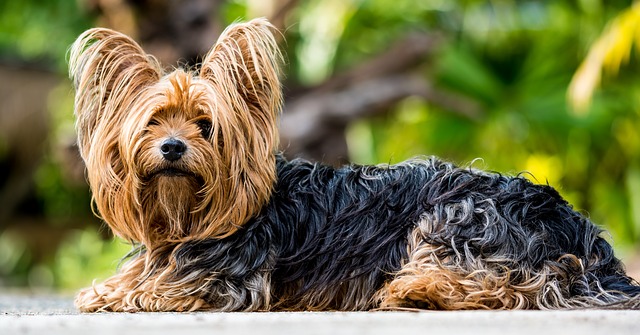
Another small Terrier that wins hearts and minds is the Yorkie, named because it hails from Yorkshire, England. This incredible bundle of fun doesn’t lose its beautiful hair.
The Yorkshire Terrier arrived in Yorkshire when workers from Scotland brought small dogs with them. The first Yorkshire Terriers came from three little dogs – Emile named Old Crab, a female named Kitty, and another unknown female. Breeders first showed them in the ‘Rough and Broken Coated dog show category. The classification of these dogs, as can be seen, was absurd. In those days, almost any dog in the shape of a terrier was a Yorkie.
The first famous Yorkie was a little dog named Huddersfield Ben. People quickly took this incredible dog. Everyone wanted its puppies. He became the ‘father of the breed.’
The dog came to North America in 1872. The American Kennel Club registered the first one in 1885. Because they embraced English customs, they took to the Yorkie. Its popularity declined in the 1940s. Oddly enough, it was a war dog during WWII. The American Kennel Club recorded it as the 6th most popular breed in 2012.
The Yorkie has a self-important air. It is active and can be overprotective of its possessions. This little fellow is quite an attention seeker.
Yorkies are prone to Bronchitis , Cataracts, and a skin condition known as Keratitis Sicca. Like some terriers, it can have a weak digestive system. It may also be susceptible to falls.
Yorkies have long hair, and combing through it daily with a rake is a must. Use a detangler to remove mats. Split the hairs into sections and go over each carefully. Work from the head to the legs.
20. Irish Terrier

The Irish Terrier is a dog that comes from, of course, Ireland. One of the oldest terriers, it doesn’t shed.
No one knows much about its origins, but experts believe that it descended from black and tan terriers like the Kerry Blue and Wheaten. Some conjecture that it may share bloodlines with the Irish Wolfhound.
The dog became the favorite of the Irish from all walks of life. It was the guardian of the poor and the darling of nobility. People bred it to hunt vermin. They weren’t selective, and coats of all types were acceptable.
Breeders began to select Irish Terriers more carefully in the later part of the 19th century. They set up the first breed club in 1879. The dogs arrived in the United States in the late 19th century and were well-received.
This dog is healthy and isn’t allergic to food. Some Irish Terriers may develop hip dysplasia. There may be an incidence of cataracts.
The Irish Terrier is active. It needs constant mental and physical stimulation. It excels in sports like dog agility, and is highly sociable. It should be in a calm and rested state at home, and become active quickly.
Irish Terriers can have a dominant streak, especially with other dogs. Socialization is necessary. They have good tracking noses and can detect scents fast.
This terrier has a rough coat that should be brushed with a Bristle brush regularly. It needs stripping with a non-cutting knife so that it remains weather resistant.
21. Kerry Blue Terrier
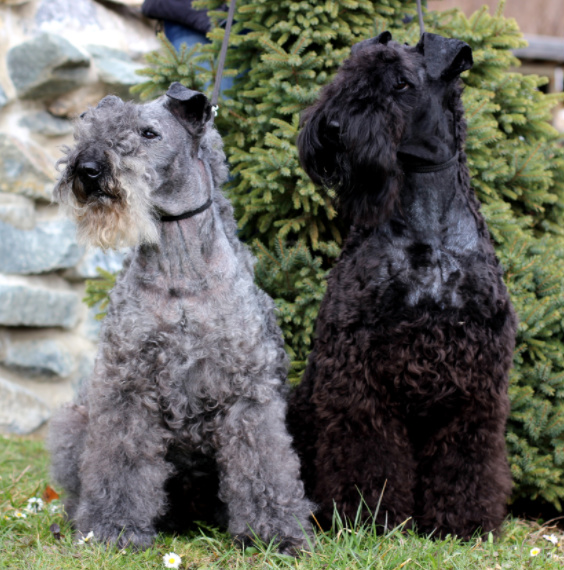
The Kerry blue Terrier also calls Ireland home. Breeders developed it to catch vermin on Irish farms. Farmers also rely on it to herd sheep and cattle. This working dog doesn’t shed and looks good on the job.
The Kerry Blue Terrier has the honor of being the national dog of Ireland. It comes from the mountains of Kerry, from which it gets its name. Breeders found its coat so lovely that they mated it with female Wheaten Terriers. The Kerry was a hybrid of the Bedlington Terrier and the Wheaten.
Dog shows took place more often in the 19th and early 20th centuries. With their development, the breed became standardized. Irish national leader Michael Collins owned a famous blue Terrier he christened Convict 224. He even tried to make it the Irish National dog.
The Kerry Blue Terrier deserves the honor. So well-received was this dog fighting for and against the formation of the Irish Republic loved it.
The Dublin Irish Blue Terrier Club held its first show, and people from both sides of the political divide entered. The event led to the formation of the Irish Kennel Club. The Kerry Blue Terrier was the first dog registered.
Kerry Blue Terriers are resilient and healthy. Older ones may be prone to cataracts and entropion(inward-turning eyelids). Hip dysplasia (dislocation of the hip bone) it’s also quite common.
The Kerry Blue Terrier is the dog for you if you value a pet that is spirited and is willful at times. It won’t come to you just because you call it; it is capable of assessing situations and making independent decisions. Its intelligence allows it to perform well in obedience and agility events.
You will also love this long-legged dog because it has a hypoallergenic, non-shedding, coarse coat. Like other Terriers, you will need to brush it frequently with a bristle brush.
The Kerry Blue Terrier doesn’t shed, but its coat requires clipping. You may choose to have it professionally clipped or to do the work yourself. Use a Number 10 or 15 clip for its head. Run it in the direction of hair growth and ensure that it has a long ‘beard.’ Scissor the edges of the ears. Run it against the grain when cutting the hair of the cheeks.
Clip the areas around the anus, tail, and privates about 2 cm above the skin. Cut off the extra hair along the legs, brisket, neck, and tail.
22. Lakeland Terrier
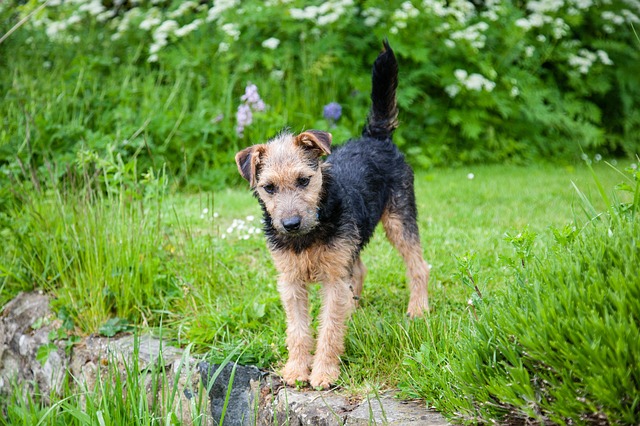
This handsome fellow gets its name because it originates from the Lake District of England. It is a mid-sized member of the Terrier family.
The United Kingdom Kennel Club claims to have recognized the breed in 1921, but the Lakeland Terrier Club says that the recognition happened closer to 1928. It attained homogeneity in 1925 after a Lakeland crossbred with a fox terrier and an Airedale Terrier. Breeders set up the Lakeland Terrier Club in 1932 and promoted the breed throughout England. The UK Kennel Club itself sanctioned the shows.
The mountainous Terrain of the Lake District made fox hunting difficult. Hunters needed a dog that could chase after foxes in such a rough environment. The great stamina of the Lakeland enabled it to do this job. The Lakeland that bred for work is also known as the Patterdale Terrier.
It is one of the earliest members of the terrier group and dates from the 1700s. Its ancestors are Old English tan and Fell Terriers. Farmers used it to hunt vermin on their grounds. The Lakeland is one of the dogs eligible to compete in Earthdog trials.
A famous Lakeland is Zelda Van Gutters, the roving reporter of Nickelodeon magazine. Another is Bill Cosby’s award-winning show dog, Awesome Blossom. Neil Tennant, the singer for The Pet Shop Boys, owns a Lakeland named Kevin.
It is the smallest of the long-legged Terriers and weighs only about 8 kilograms. It is finer-boned then its Welsh Terrier cousin. The Lakeland is sturdy, with a narrow chest and a broad muzzle.
The Lakeland is a typical Terrier that’s sociable, bold, and confident. Training it is not difficult because it is eager to learn. Like other Terrier breeds, it has selective deafness and won’t respond at once when called. The behavior isn’t a sign of a lack of intelligence; in fact, it’s just the opposite. It is capable of assessing a situation before responding to you.
The Lakeland can become bored and destructive if it doesn’t receive physical and mental stimulation. Since they catch rodents, they have a high prey drive. Keep them leashed when in parks and other public areas.
This dog is healthy but may develop minor conditions such as hip dysplasia and patella luxation.
Like other Terriers, It has a wiry, coarse outer coat that does not shed. It needs daily brushing to remove dead hair and regular stripping. A stripping knife will do the job well.
Try not to use clippers on its hair because they will lighten its color. Use the number ten clipper around the head to avoid cutting the hair too short.
23. The Standard Schnauzer
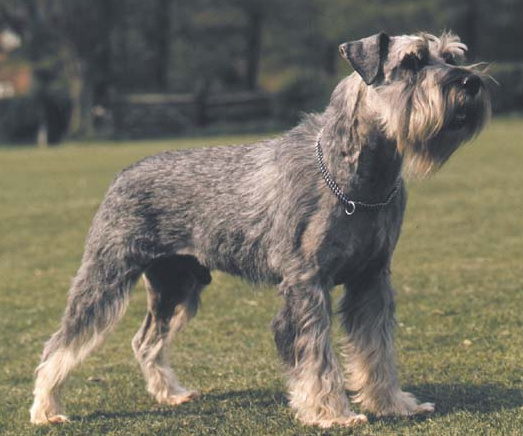
Meet the ‘ second’ brother of the Mini Schnauzer. It’s slightly larger than the mini and smaller than the Giant. It has qualities similar to the other Schnauzer types.
Like its elder and little brother, it has German roots. It came from Germany in the 16th century. The word ‘ schnauzer’ means ‘ snout.’ Schnauzers are renowned for having bearded snouts.
Schnauzer-type dogs developed from ratting and herding breeds. A typical working dog, it helped German farmers catch rodents and herd livestock. The advent of dog shows in the 19th century saw it capturing the interest of dog enthusiasts. These breeders standardized its appearance for the show ring. Hence, the schnauzer has a look that we all know and love.
They began to mix early Schnauzers with Poodles. The combination gave the Standard Schnauzer a regal look. Kennel clubs classified the earliest Schnauzers as German Pinschers because of its salt and pepper coat. The word ” Schnauzer’ became the synonym for the wire-haired Pinscher.
The dog with the bearded snout first appeared in the show ring in 1842. The first Schnauzer, aptly named ‘Schnauzer’ one the 1879 Hanover Show in Germany.
It came to the United States in the 1900s. People kept the modern Schnauzer for various purposes. The Red Cross used Schnauzers for guard duty during World War I. Police departments rely on their keen senses of smell as well. These intelligent dogs excel at obedience and agility activities.
This dog has a stiff, wiry coat that sheds to a limited degree. Daily brushing with a bristle brush and stripping keeps it weather resistant. Regular grooming will prevent hair fall.
As mentioned before, this dog is highly intelligent and affectionate. It is aware that it is smart, and can get up to a bit of mischief. The good news is that it loves to please its owner.
Schnauzers are healthy but may develop cataracts as they age. They gain weight if overfed, and can have thyroid- related issues.
Brush your Schnauzer’s hair under the arms, belly, and between the legs, working in the direction of hair growth. Use a detangler to remove mats. It will not have many if groomed regularly. Dry the fur.
Then, clip the fur with a number 10 blade. To give it the Schnauzer cut, start at the base of the dog’s skull. Move along the back to the tail. Continue in the direction of the hair growth until you reach its underbelly. To cut the hair around the tail, follow the grain as well. Remember to clip the hair around the joints above its legs.
24. The Tibetan Terrier
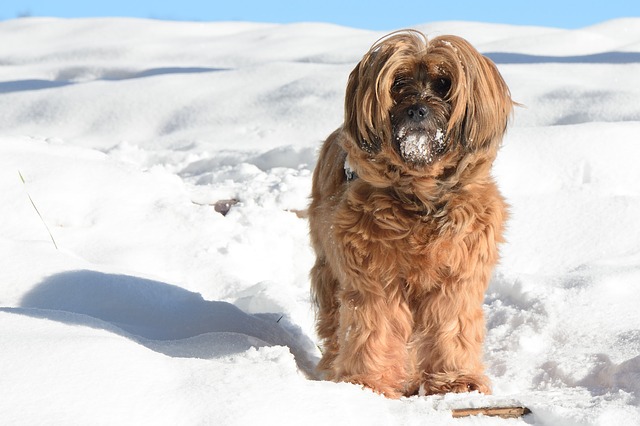
If you want a charming dog that looks like a snug Mongolian curtain, welcome the Tibetan Terrier into your home. Don’t let its name fool you because it isn’t a member of the Terrier group. European travelers gave it the name because it resembled a Terrier.
Its Tibetan name is Tsang Apso and has been around for thousands of years. It has the name ‘ Holy dog of Tibet’ because it was a good luck charm for the Tibetans.
Monks gave Tibetan Terriers as blessings of Good Fortune. No one sold them, which meant that they were rare. There were only a handful of foundation dogs. Tibet’s isolated geographical location meant that these dogs were purebreds for many years. .’ referred to them as ‘The Little People.’ It was blasphemy to mistreat them.
Dr. ARH Greig brought the first one to Europe in 1922. A patient gave her a Tibetian Terrier named Bunti as a gift for successfully operating on him. After getting a male, Rajah, she established a kennel for breeding. The first litter was born in 1924, and Dr. Greig named them Lhasa Terriers.
Dr. Henry and Mrs. Alice Murphy brought the first ones to America in 1973. The American Kennel Club acknowledged the breed and classified it as a non-sporting dog.
The Tibetian Terrier’s temperament explains why people love it so much. They are devoted, affectionate family pets. They do well in small spaces. These dogs are intelligent; they do well in agility and obedience activities.
They are susceptible to a few health problems, including hip dysplasia(dislocated hip), patella luxation(dislocated femur), and progressive retinal atrophy(degenerative eye disease).
Get it used to the grooming process as early as possible. Tibetian Terriers have long hair, so you need to go through it with a rake comb. Remove mats with a detangler or silicone gel.
Its coat needs regular clipping as well. Always start from the head and work your way along its back. Move down its legs and cut the hair on its underbelly. Trim the hair around its tail. Use the Number 40 blade on your clippers as you’ll want to avoid cutting its coat too short.
25. The Wheaten Terrier
You can consider the Wheaten as having dual citizenship. This non-shedding terrier’s coat is either more American or Irish.
Like its terrier cousins, farmers bred it to catch the vermin on their properties. It also helped them with herding and guarding the surroundings. It shares the same bloodline with the Kerry Blue Terrier and the Irish Terrier.
Unlike the Kerry, the Wheaten wasn’t a gentleman’s dog. The regular folk who owned Wheatens docked their tails to avoid paying taxes. The Irish Kennel Club didn’t recognize the Wheaten until 1937. The British Kennel Club registered it in 1943.
Lydia Vogel brought the breed to America in the 1940s, but it took another ten years to develop. The Anubis Kennels brought it to Australia in 1973. The American Kennel Club recognized it that year as well.
Wheatens live for a long time. Having said this, they may be prone to protein-wasting diseases like protein-losing neuropathy, when they lose this nutrient via the kidneys. They may also develop protein-losing enteropathy, which occurs when their digestive tracts can’t absorb protein. Other issues are dysplasia (bone dislocation) and Addison’s disease (insufficient steroid hormones).
These dogs are playful, energetic, and make excellent companions. Use positive reinforcement when training them because they may become aggressive. They are affectionate and love to jump in greeting. The Irish call it the Wheaten Greeting. They are more active than the average terrier.
Wheatens can have red, brown, mahogany or white wiry coats. The Irish Wheaten has softer hairs than an American one. Slicker brushes work best for regular brushing.
When trimming the face, cut the hair from the front of the ear to the middle of the eye. Trim the hair around the eyes so that there are no mats. Use shears to flatten the coat. Use the number 40 clippers to cut the hair around the belly, legs, and rump.
26. Airedale Terrier
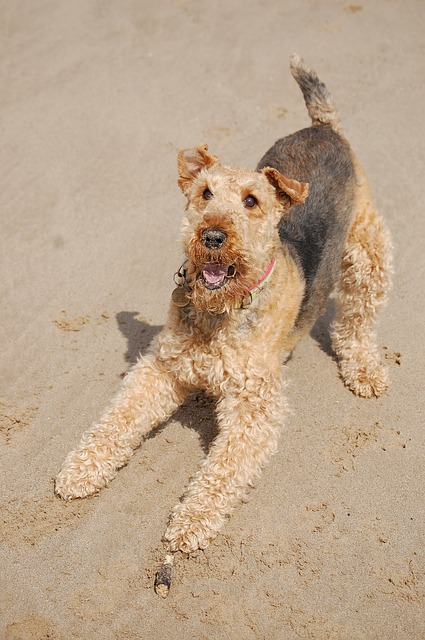
If a fluffy, large dog is what you want in a pet, the Airedale Terrier is for you. This friendly giant is a bundle of fun and doesn’t shed as it plays.
This fellow comes from the River Aire. Its parents were the black and tan Terriers, the bull terrier and the Otterhound. It served as a working dog on farms. The police used it for its keen sense of smell and tracking abilities. Hunters developed it to retrieve game.
An Airedale is flexible, and can maneuver after quarry despite its size. This fellow wasn’t only able to retrieve game. It could put up a good fight against scavenging foxes as well. It was a multipurpose animal suited to many tasks.
The Kennel Club of England registered it formally in 1886. Breeders showed it for the first time at championship dog shows in 1864. They called it the rough-coated Bingley.
Fanciers settled on the name ‘Airedale Terrier,’ which the Kennel Club of England accepted in 1886. They were in the ‘Sporting Dog’ class. They took part in sporting events along the River Aire. Judges assessed them on their ability to locate ferrets in holes.
The first Airedales came to North America in the 1880s. The first one to arrive in the United States was a stud named Bruce. It triumphed in the terrier class in the New York Dog Show. CH Master Briar, a dog that lived from 1897 to 1905, was the father of the breed.
The Airedale Terrier Club of America offered the Airedale Bowl as a long-standing trophy for Airedales that performed well in dog shows and agility events. The practice continues today.
The dog carried messages for soldiers during the First World War. It served as a sentry for the red cross. Lieutenant Colonel Edwin Hautenville, who established the British War Dog School, secured two of them to bring comfort to British soldiers on the battlefield.
The Russian Red Army used Airedales as war dogs in the 1920s. Their popularity increased after the First World War. These dogs first served as police sentries under Superintendent Dobies of the North Eastern Railway Police.
The United Kennel Club registered the Airedale in 1914, while the American Kennel Club recognized it in 1888. The Airedale Terrier Club of America, founded in 1900, is the parent club of the breed.
This breed is prone to a few health problems. Airedales have suffered from cancer and heart disease. They may experience eye disorders as well.
The Airedale’s coat protected it from predators. Clipping it may leave dead hair within the follicle, and it can trigger skin irritations.
Hence, its coat needs regular brushing with a bristle or pin brush. When clipping its hair, work from the head down to the back, moving in the direction the hair grows. It is a slender dog, so trim its neck, brisket, and legs closely.
Its thighs should remain heavy coated. Cut the hair on its back legs cleanly. The skull should have a close trim, with plenty of hair over the eye. Trim the cheeks closely too.
27. Bouvier Des Flandres
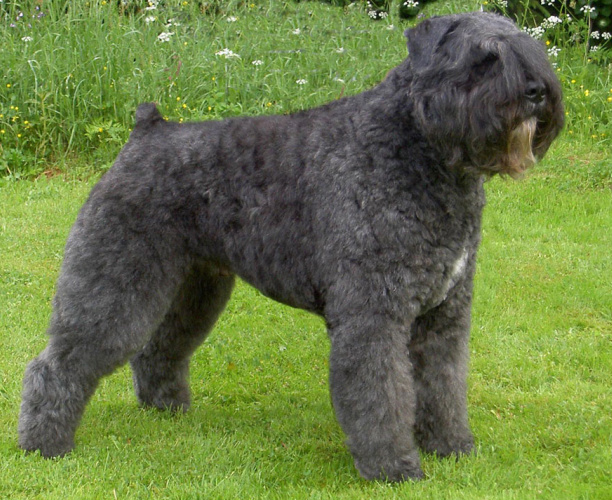
Do you need a dog to round up your kids or other pets? Consider the Bouvier Des Flandres.
This herding dog comes from Belgium. Like many other dogs, they served on farms and assisted with the gathering of cattle. Many are guard dogs and police dogs. Its name means ‘Cow Handler of the Flanders.’
The monks at the Ter Duinen monastery first bred these dogs. They were crosses from Irish Wolfhounds and Deerhounds. The result was a working dog that could gather cattle and even haul large carts. The Bouvier’s strength was renowned.
It was not a clearly defined breed up to the early 20th century. Several local kennel clubs in Belgium acknowledged it in 1912 and 13.
The breed disappeared shortly during WWI. The Bouvier served in the military, and many died in trenches. A new stock emerged in 1936. It became endangered again during WWII. Owing to these setbacks, the Federation Cynologqique Internationale only acknowledged it in 1965. A notable Bouvier was President Ronald Regan’s dog, Lucky.
The Bouvier is naturally protective and loyal. It makes an excellent pet and guardian. Breeders don’t breed it for aggression. Instead, it has a sophisticated sense of self-control. It is obedient to is master and fearless. It requires positive training. Socialize it well, especially around children. How well a Bouvier behaves depends how well its owner communicates with it.
This fellow has a sturdy build. It’s large without being clumsy. It’s most notable feature is its large head and mustache. It has a docked tail because of its propensity for injury.
Bouviers have a luxurious, dense black coat. They need regular brushing with a slicker brush. Remove all mats with a detangler. Start at the left back leg and work towards the head. Clip the head hair with a number 10 clipper. Use scissors to clip the ears. The hair should be 2 inches above the skin.
28. Irish Water Spaniel
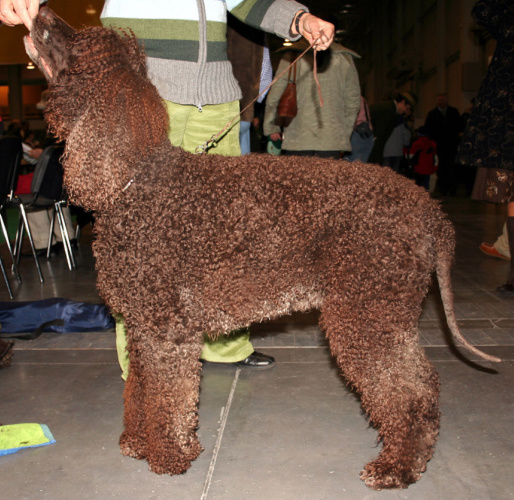
Do you love large, gentle dogs with floppy ears? Meet the Irish Water Spaniel. This big fellow is one of the largest breeds registered by the American Kennel Club.
This dog is a native Irish breed that appeared about a thousand years ago. It is the descendant of the Dobhar Chu. There is much debate about its ancestry. Some say that it is a cross between a Poodle and a Spaniel. Others say it descends from Afghan sounds.
It is a hybrid of various Spaniel breeds. It comes from two primary strains – the South Country water spaniel and the North Country water spaniel.
The dog started to perform at dog shows by 1869. A gentleman by the name of Justin McCarthy tried to isolate the breed as we know it today. He blended the varieties to become a distinct type of dog. He fixed the standard and gave the dog individuality.
Irish and English hunters received the breed well. It was hardy, and its resilience was renowned in North America. It was the third most popular dog in the United States by 1885.
Like other sporting dogs, the IWS is an active and energetic fellow. Since it comes from a line of retrievers, it is born to please. It also has a strong team spirit. The IWS is an intelligent dog that has a great sense of humor and will try to get attention with all kinds of antics. It will go out of its way to achieve what its owner expects of it.
This cobby, sturdy dog doesn’t shed much. Its long, curly coat has a distinct purple hue. Groom it regularly with a greyhound comb and a rake. Keep its hair clipped.
29. Giant Schnauzer

If you want a sentry, the Giant Schnauzer is ready and willing to be of service. This gentle giant, like its mini and middle brothers, doesn’t lose much hair. It hails from Germany.
The first giant schnauzers came from Swabia in Germany. Breeders thought of them as rough-coated versions of German Pinschers. They were also a blend of Great Danes, German Shepherds, Rottweilers, Boxers, and Dobermans.
Farmers used it to guard and drive livestock. It was efficient security guards as well. It eventually moved into cities where it protected factories, breweries, and other buildings. No one knew much about it until it served as a military dog during the and first and second world wars.
Giant Schnauzers arrived in the United States in 1930 and were a rare breed until the 1960s. The American Kennel Club registered 386 of them by 1974. That number rose to 1000 by 1987. The police rely on its alertness and tracking abilities. It excels in agility and obedience activities.
This dog is quiet, but don’t mistake this for timidity. It can be territorial. However, once socialized and comfortable, it will accept new people and pets. You can trust it around your kids.
Hygiene is a concern with is breed, as its food may collect in its beard and trigger infections. It could suffer from dysplasia and degenerative eye diseases like progressive retinal atrophy. Skin tumors and cysts are common.
It isn’t a giant when compared with other dogs, but with its Schnauzer relatives. A male measures about 65 cm, and a female, 60 cm. Like other Schnauzers, it has button ears and a docked tail.
This dog has a thick, coarse overcoat and a soft undercoat. It needs brushing with a bristle brush and requires hand stripping. Note that clipping will change the dog’s hair color over time. It may lose hair.
When clipping the coat, work from head to the tail. Cut the hair under the leg joints. Clip the hair around the eyes to make it appear as though it has eyebrows, and avoid cutting the beard too short.
30. Komondor
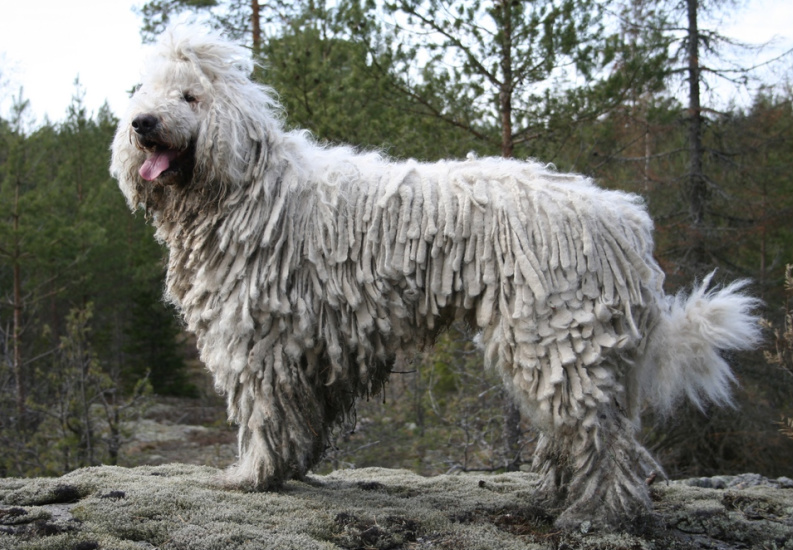
Do you want a dog that you can double as an attractive living room curtain or a mop? The Komondor is the dog for you. It will always look like one because it doesn’t shed.
The Komondor is a German sheepdog that hails from Hungary. Don’t let its mop-like appearance fool you; it’s physically agile and powerful.
German farmers bought the Komondor to Europe in the 14th century. As they did with the Giant Schnauzer, farmers used it to guard livestock and property. The first mention of it was in 1544 in Kakyoni Peter’s History of King Astiagis. It is one of Hungary’s national treasures.
The Cumans, who fled from Mongolia when the Mongols expanded their territory, first brought Komondors to Hungary in the 12th and 13th centuries. Hence, the name Komondor means Cuman Dog. Archaeologists found their remains in Cuman graves. It is common in Hungary and Germany today.
The Komondor’s primary role as a guardian means that it is extremely alert and suspicious of strangers. Once socialized, however, it is affectionate. Like most guard dogs, it will knock down Intruders and keep them down until you come to deal with them. Of course, it must be well-trained for this purpose.
This dog is a hefty Molosser breed, and it’s beaded coat covers its entire body. It is robust and has strong muscles. Looking after it takes effort; you will need to spend time separating the beads so that they don’t become entangled. Comb through them with a rake and clip the hairs with a number 10 blade to avoid cutting the hair too short. You will want it to retain its signature look.
Because it has very long hair, it seldom sheds. It only loses hair as a puppy, when it’s long hair starts to form. The beads increase over time. Its dense coat makes it unsuited to hot weather.
31. Portuguese Water Dog
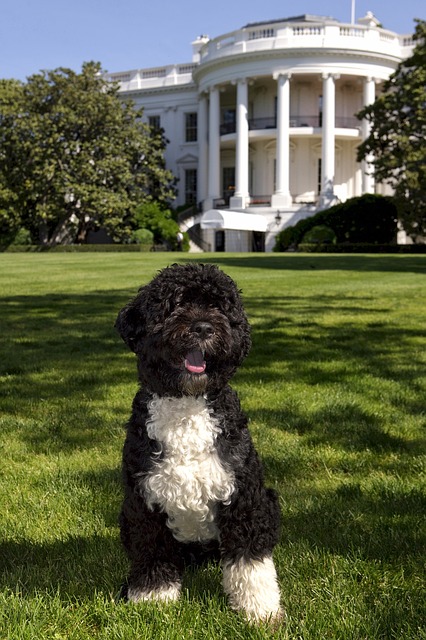
Here is a dog who won’t mind serving as a life raft. The Portuguese Water Dog is here to take a swim with you.
This friendly fellow comes from the Algarve region of Portugal and was an assistant to fishers. They gathered fish end retrieved lost tackle.
Some breeders believe that it originated in the Asian steppes, and was a progenitor of the Poodle. Hence, the Portuguese Water Dog and the poodle could share the same lineage.
Others believe that it went to fight the Romans with the Visigoths and became the Lion Dog. In 1297, a monk recalled that a black dog with a rough coat pulled him from the sea and prevented him from drowning.
Modern Portuguese Water Dogs can attribute their lineage to a dog named Leao, who bred with so many females that it is responsible for almost have the number of Portuguese water dogs today.
Its owner was a shipping magnate named Vasco Bensaude, who kept it in his kennel, Algabiorum. His veterinarian, Manuel Fernandes, helped him with the breeding. Another veterinarian, Conchita Cintron de Castelo Branco, carried on with the work.
Antonio Cabral, a veterinarian who founded the Alvade Kennels, worked with Deyanne Miller, Sonja Santos, and others to bring the breed to the United States.
Miller was responsible for the rise of the PWD in the United States. She established the Portuguese Water Dog Club of America in 1972.
The Portuguese Water Dog is prone to a few genetic diseases. Older ones may develop hip dysplasia (a dislocated hip). Eye problems like cataracts and Progressive retinal atrophy, a degenerative eye disease, may plague them as well.
This dog is faithful, independent, highly intelligent, and trainable. It has a long memory and can form associations with objects. It can follow complicated instructions and has a powerful retrieving instinct. You may want to limit this behavior, lest it harms your small pets.
As a guard dog, it is watchful but friendly towards strangers when socialized. Because it is a working dog, it’s content to accompany its master.
The PWD is gentle but isn’t for everyone. Don’t own one if your lifestyle is sedentary, as it needs lots of physical stimulation. The PWD has a long coat that will grow indefinitely if not clipped. Brush it regularly with a slicker brush.
You may want to give the dog a Lion Cut. In this case, shave the dog’s legs and tail. The hair on its head is more than the rest of its body. Give it a Retriever Cut instead. The Retriever Cut is even, and the length, flexible.
32. Saluki
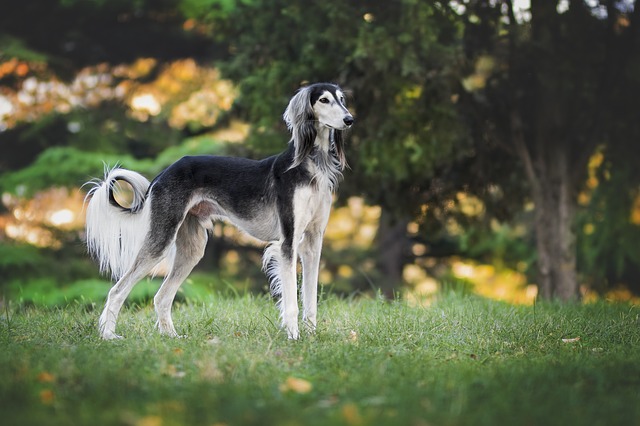
Fancy a little Arabian chic? The Saluki, or Arabian Greyhound, has true Arabian charm. And, it doesn’t lose its hair.
This sleek sighthound comes from the Fertile Crescent. It hunts by sight and kills quarry for hunters. They use it for this purpose today.
The people of the Fertile Crescent bred Saluki dogs as early as 6000 years ago. Archaeologists discovered pottery, from Susa, adorned with their images. The Egyptians depicted them from the Middle Kingdom onwards, but it was during Egypt’s 18th Dynasty that they became prominent. The Egyptians started to draw them instead of the Tesem, the dogs with pointed ears usually seen on Egyptian artifacts.
The poetry of Khagani mentions this dog as well. Prominent Arabian artists like Kamaludin Behzad characterized it in their works.
The Saluki eventually found itself in Europe. The breed became known when returning Crusaders brought a few Salukis back with them from the Middle East.
European artists began to feature the Saluki. The dog depicted in a painting of Henry IV was a Saluki.
Sheik Hamad Bin Isa Al Khalifa, who ruled Bahrain in the 1930s, owned a pack of Salukis which he used for hunting. Spurred by his efforts, his son, Dana Al Khalifa, registered them with the Kennel Club of Bahrain.
The Saluki remains popular in the Middle East, though less so elsewhere. In Europe, Florence Amherst started to breed Salukis in 1895. She struggled to keep its bloodline pure. Hence, the Saluki wasn’t well-received until after the First World War, when returning soldiers brought a few Saluki puppies home with them.
One of them was General Frederick Lance. He and his wife, Gladys, valued the Saluki for its ability to hunt. They imported a male, Sarona Keib, which became an influence for Saluki breeding in Europe.
The Lances and Florence Amherst eventually worked together to champion for the recognition of the breed. The Saluki Club formed in 1923, and the Kennel Club gave the breed recognition.
But breeding stopped after the war years. Many countries imported English descendants of Sarona Keib, but interest waned by the mid-1930s. Breeding halted during World War 2. Owners euthanized many Salukis, preferring that the dogs died humanely instead of being bombed.
The breed is ranked the 107th most popular by the American Kennel Club. Though not the most popular, people have received it reasonably well. The Kennel Club had registered them in 2014.
The primary cause of Saluki deaths is cancer, according to a Survey by the Kennel Club and the Small Animal Veterinary Association. Heart defects are also common in this breed.
Like other sighthounds, it can be a little reserved with strangers. They are willful, so have a lot of patience when training them. Also, they bore quickly, so don’t leave them alone for too long.
Salukis come mainly in fawn or tan, though attractive colors like white, cream, gold grizzle-and-tan and black-and-tan are possible. This hound has a soft, smooth, low-maintenance coat. Use a greyhound comb when grooming it. Feathering on the tail and back of the thighs is particularly prominent; comb the hairs regularly.
In conclusion, you don’t have to put up with pet dander because you have a dog. Many that don’t molt or have excessive dander. Also, regular grooming eliminates, or at the very least, reduces shedding.